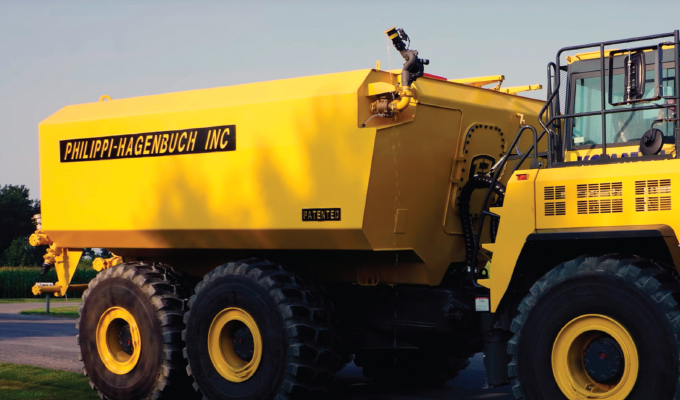By Josh Swank
Site safety and efficiency are two of the main reasons why spraying haul roads is common practice. Yet ironically, the equipment many operations use to wet the roads is neither the safest nor most efficient option. The secret to finding the ideal solution lies within the water tank’s design and spraying system.
DON’T CUT CORNERS
Square tanks haul about 20% more water than rounded tanks with the same basic exterior dimensions. They also improve safety by creating a lower center of gravity. Curved sides raise the water’s center of gravity, reducing stability. Rounded sides also contribute to water churning since there aren’t corners to slow the water’s momentum. This sloshing can shift the center of gravity, making the truck unstable and unsafe. Drivers who can feel water surging often mitigate the problem by not filling the tank completely, in turn, wasting time and fuel on unnecessary trips to refill. And, at the end of the day, each truck covers far less ground.
SPRAY SMARTER
Providing drivers with precise control of the tank’s water output increases efficiency. Individually controlled spray heads make it easier for drivers to optimize water use while reducing the risk of oversaturating roads. Operators can turn on the individual spray heads and, with some systems, program a spraying interval to cover a greater surface area without making the roads too slick.
Water-metering controls also increase driver safety by allowing him or her to focus more on the surroundings and less on water output. Remote controls can further improve safety by keeping drivers out of harm’s way—especially when battling fires. Traditional systems require the operator to use a joystick and monitor in the cab, but some remote-control systems allow control of a water cannon from as far as half a mile away.

BAFFLINGLY SAFE
A tank’s baffling system affects both safety and efficiency as it prevents water from surging side-to-side and front-to-back. Almost all water tanks feature baffles, but some designs are more effective than others.
Many baffles have large holes for maintenance personnel to access individual compartments through which water can also move freely, resulting in surging. While baffles require holes for water to flow throughout the tank, they should be small enough to prevent surging. Additionally, some tanks feature baffling from floor to ceiling, as well as along the complete length and width of the tank, for more complete compartmentalization. Others take it even further with side-surge stabilizers along interior walls to prevent water from churning within individual sections. These added measures go a long way toward improving tank stability and overall safety.
CLOSING THOUGHT
Anytime safety and efficiency are the main objectives, using equipment that falls short in either category doesn’t add up. When evaluating future tank purchases, take a close look at how its design lends itself to accomplishing these goals.
About the Author:
Josh Swank, vice president of sales and marketing for Philippi-Hagenbuch, oversees their global sales team and has been with the company for more than 20 years. Engineering innovative haul-truck solutions for over 50 years, Philippi-Hagenbuch Inc. is located in Peoria, Illinois, and has been building equipment for off-highway haul trucks since 1969. During this time, PHIL has become the global leader in off-highway truck customization. In addition to their innovative tailgates, push blocks, rear-eject bodies and trailers, Philippi-Hagenbuch designs and builds end-dump bodies, trailers, sideboards, load ejectors and water tanks for nearly every make and model of articulated and rigid frame off-highway truck available. For more, visit www.philsystems.com.
Modern Contractor Solutions, December 2021
Did you enjoy this article?
Subscribe to the FREE Digital Edition of Modern Contractor Solutions magazine.



